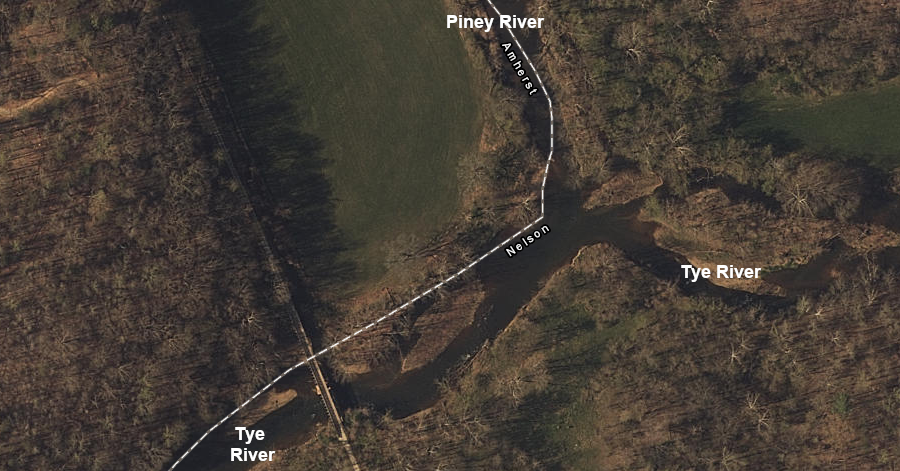
the Virginia Blue Ridge Railway is now a 7-mile hiking trail that crosses the Tye River east of Roses Mill
Source: ESRI, ArcGIS Online

the Virginia Blue Ridge Railway is now a 7-mile hiking trail that crosses the Tye River east of Roses Mill
Source: ESRI, ArcGIS Online
The Virginia Blue Ridge Railway connected Massies Mill to the Southern Railway line at Tye River, on the eastern side of the Blue Ridge. Today, the route of the railroad is a hiking trail.
The Tye River Timber Company and the Leftwich Timber Company started the rail line in 1914. They shipped lumber cut from chestnut trees from mills at Woodson and Massies Mill to markets on the East Coast. The railroad was built up the Tye and Piney rivers, with a six-mile extension built to Massies Mill in 1916.
The original plan was to extract the timber before the chestnut blight ruined it, but the US Government force the railroad to suspend operations during World War I from January-November 2018. After the loss of the primary commodity hauled by the railroad, it struggled to make a profit from shipping other local products. Orchards shipped apples and materials, and the mill at Massies Mill manufactured barrels for that product. The Great Depression reduced traffic, and the Virginia Blue Ridge Railway stopped passenger service in 1936.
The four-mile branch to Woodson was abandoned in 1939, after being unused and unrepaired for five years. Tye River and the Leftwich Timber companies merged into the Tywich Corporation in 1944.
Starting in 1931, the railroad began shipping titanium ore from the Southern Mineral Products Corporation quarry on the Piney River. In 1939, the Riverton Lime & Stone Company opened an aplite quarry and began shipping the quartz/feldspar rock to factories that used the raw material to make insulation, roof shingles, and other products. Another company opened a second quarry in 1941, and the traffic helped keep the Virginia Blue Ridge Railway economically viable.
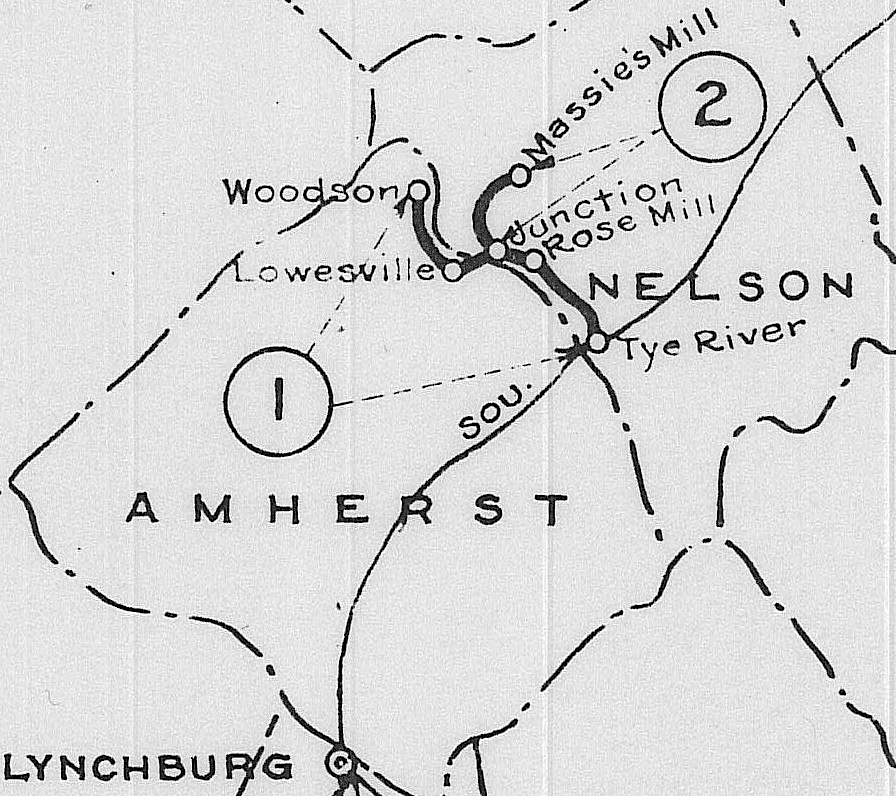
the Virginia Blue Ridge Railway connected to just the Southern Railway
Source: National Archives - Railroad Valuation Maps, System Index Map
After the American Cyanamid Company acquired control of the titanium mining and processing operations in 1944, rail traffic expanded. The Virginia Blue Ridge Railway transported materials such as sulphuric acid and limestone to the processing plant that converted ilmenite ore into titanium dioxide pigment, increasing the amount of inbound traffic handled by the railroad.
The railroad operated with coal-fired steam engines. The Virginia Blue Ridge Railway was able to purchase used steam locomotives at low prices, first from the War Assets Administration and the US Army after World War II and then from other railroads as they converted to diesel engines. One company executive blocked the switch from steam engines, but after he died the railroad purchased diesel equipment in 1963.
The last day of steam operations was August 1, 1963. The railroad delayed sale of two steam engines and considered operating them for tourist ("ferroequinologist") trips, but then sold the engines in 1964. Four of the last five steam locomotives have ended up being preserved rather than scrapped.
After 40 years of operations, the titanium mine and processing facilities closed in 1971. That was two years after Hurricane Camille had flooded the area and forced expensive repairs to the railroad tracks and bridges. After the IMC Chemical Group closed the last aplite quarry in 1980, the railroad was abandoned. The steel tracks were removed and the diesel locomotives were sold.
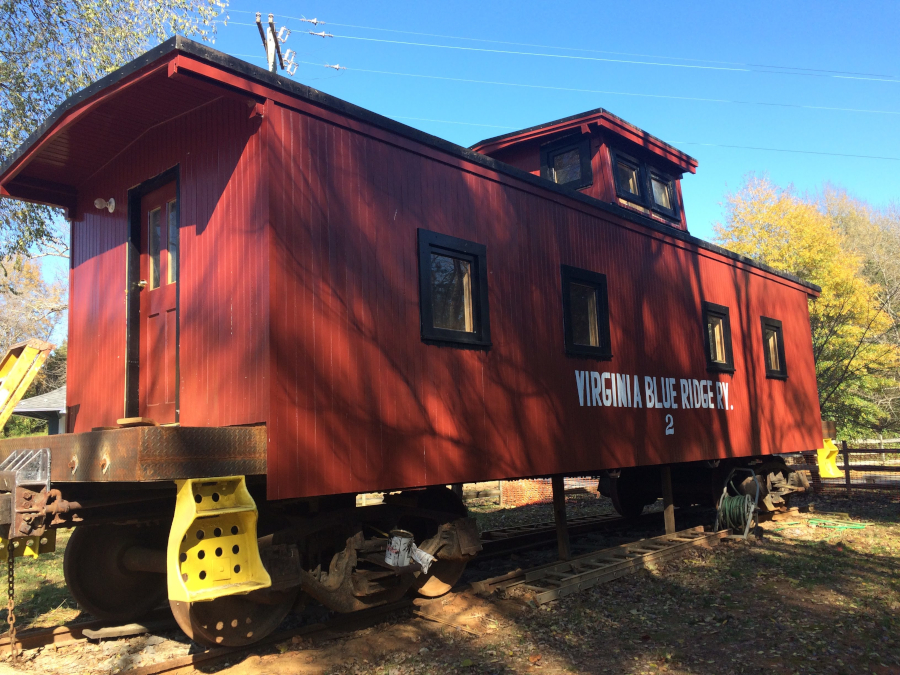
a caboose with the Virginia Blue Ridge Railway name is parked at the site of the Piney River depot
Planning to convert the right-of-way into a hiking/biking trail started in 1997. The first part of the Virginia Blue Ridge Railway Trail opened in 2003, and extended later as bridges were rebuilt to its current 7-mile length.1
"Virginia Blue Ridge Railway," Whippany Railway Museum, http://www.whippanyrailwaymuseum.net/visitor-info/virginia-blue-ridge-railway; "Virginia Blue Ridge Railway Abandonment - Finance Docket No. 12547," Interstate Commerce Commission Reports: Reports and Decisions of the Interstate Commerce Commission of the United States, Volume 236, Interstate Commerce Commission, Government Printing Office, 1940, p.411, https://books.google.com/books?id=lxnhCn4ONJMC; "Blue Ridge Railway was the little railroad that could," News Leader, July 23, 2019, https://www.newsleader.com/story/news/history/2019/07/23/blue-ridge-railway-little-railroad-could-in-nelson-county-virginia/1807081001/ (last checked August 1, 2020)
One local landowner purchased the railroad right-of-way and, with his neighbors, created a foundation to qualify for grants from the Commonwealth Transportation Board to create a gravel path for hikers and bikers. As portions of the trail was completed, the land was deeded to Amherst and Nelson counties. The landowner, Steve Martin, highighted how his neighbors and local officials were supportive of the project:2
"Blue Ridge Railway Trail gets boost in Amherst, Nelson," Lynchburg News & Advance, July 8, 2008, https://www.newsadvance.com/news/local/blue-ridge-railway-trail-gets-boost-in-amherst-nelson/article_8a856320-0d0f-5bd4-9955-d44f39c8c19d.html; "Leave your tracks on the Blue Ridge Railway Trail," Bay Journal, September 2, 2020, https://www.bayjournal.com/travel/leave-your-tracks-on-the-blue-ridge-railway-trail/article_65421464-ec61-11ea-82d6-9b208aab5e9f.html (last checked September 5, 2020)
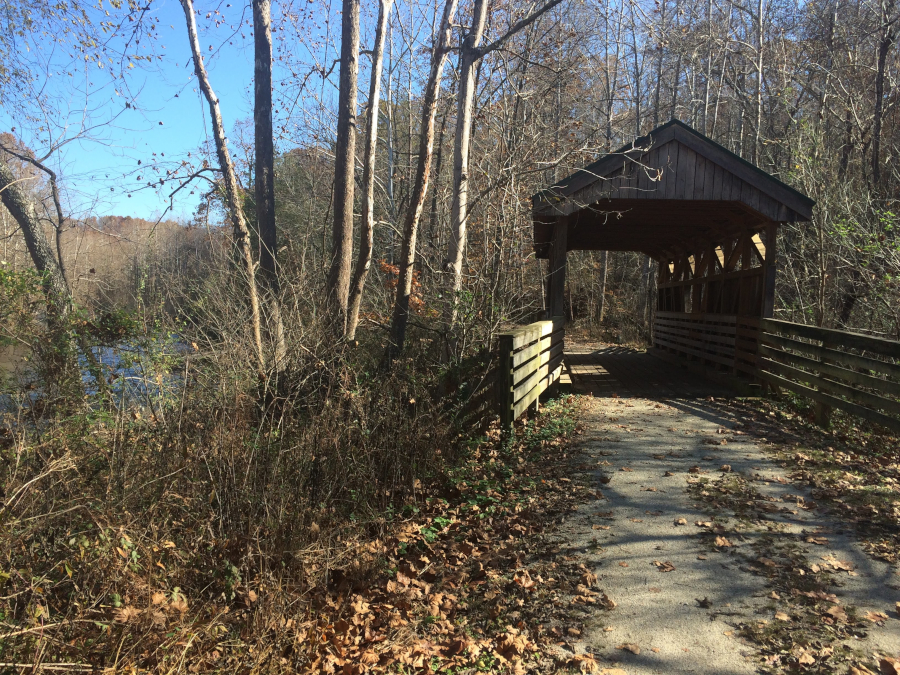
the Virginia Blue Ridge Railway trail includes a covered bridge over Naked Creek, flowing into the Piney River
The trail goes near the old American Cyanamid Company processing plant, which EPA added to the National Priorities List (NPL) in 1983 and managed as a Superfund cleanup site. Hikers on the trail are advised not to touch the water in the drainage ditch along the trail there. It may be brown in color due to ferrous iron from historical mining operations, with a pH as low as 3.5.3 "Community Update - Spring 2017," U.S. Titanium Piney River, VA, Environmental Protection Agency, https://semspub.epa.gov/work/03/2242045.pdf; "Superfund Sites in Reuse in Virginia," Environmental Protection Agency, https://www.epa.gov/superfund-redevelopment-initiative/superfund-sites-reuse-virginia#titanium (last checked November 4, 2018)
The presence of people on the trail was one factor that triggered removal of an eight-foot high "drum disposal mound" from the the US Titanium Superfund Site in 2020. Sampling revealed elevated levels of metals and chemicals, together with evidence of drums. The responsible party for the site, Aolvay, chose to remove the entire pile even though only portions were known to have tested above the thresholds. That removed the risk of high waters in the Piney River exposing and eroding material of concern.3
"Cleanup efforts continue at U.S. Titanium Superfund Site in Piney River," Nelson County Times, January 13, 2021, https://newsadvance.com/community/nelson_county_times/news/cleanup-efforts-continue-at-u-s-titanium-superfund-site-in-piney-river/article_8402d7ed-355f-5cd8-9165-b958e689b225.html (last checked January 15, 2021)
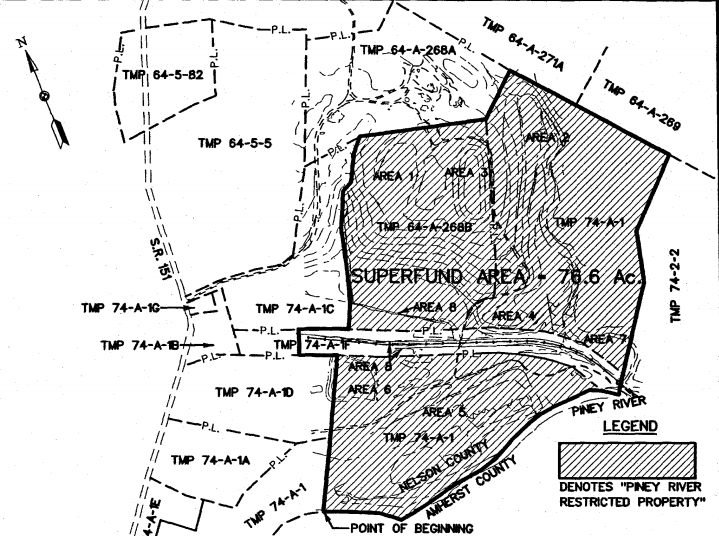
the Superfund cleanup plan at the American Cyanamid Company facility identifies the most-contaminated areas on either side of the trail
Source: US District Court for the Western District of Virginia, Consent Decree Third Modification
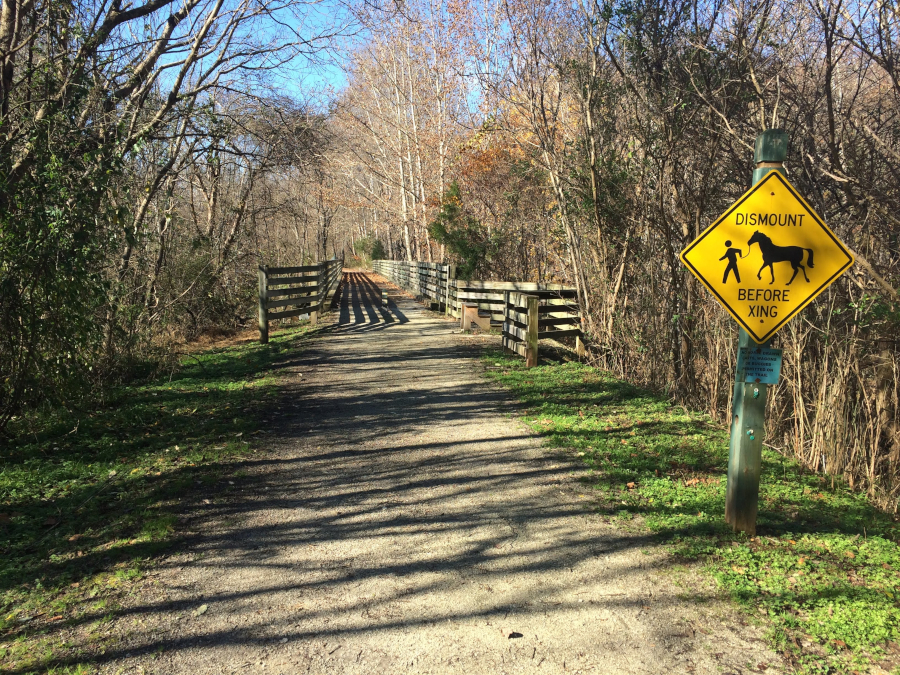
the Virginia Blue Ridge Railway trail at the Roses Mill trailhead
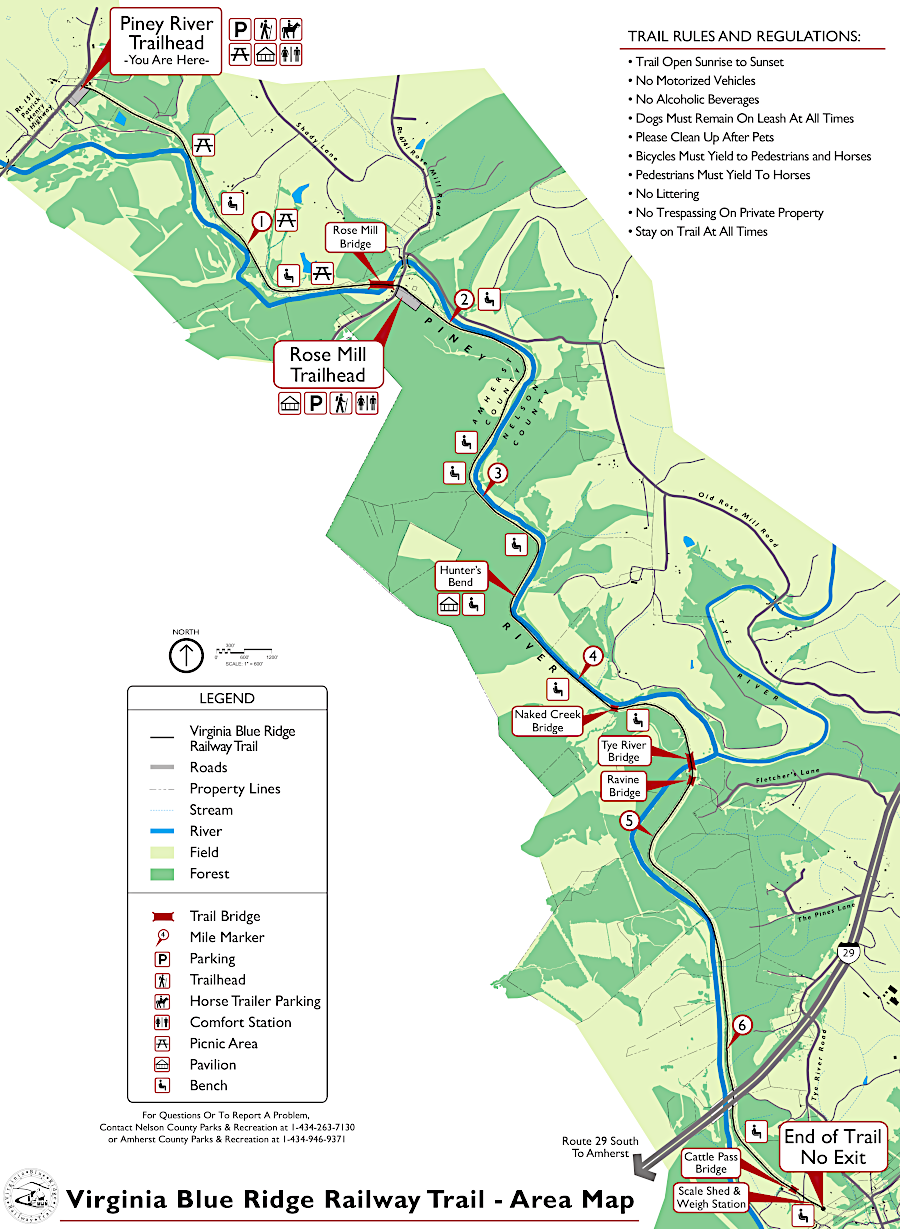
the seven-mile Virginia Blue Ridge Railway Trail currently has a dead end, requiring hikes/bikers to backtrack
Source: Nelson County, Virginia Blue Ridge Railway Trail - Area Map